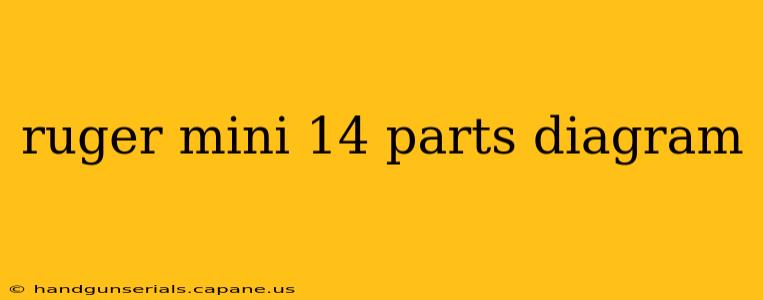The Ruger Mini-14 is a popular semi-automatic rifle known for its reliability and versatility. Whether you're a seasoned shooter performing maintenance or a newcomer eager to learn, understanding the Mini-14's components is crucial. This guide provides a detailed parts diagram and explanation, helping you navigate the rifle's inner workings with confidence. We'll cover key components, their functions, and essential maintenance tips.
Understanding the Ruger Mini-14's Key Components
While a full exploded parts diagram is best obtained from Ruger's official resources or reputable gunsmithing websites (due to the complexity of visually representing all parts), we can cover the major components here. Remember to always consult your owner's manual before attempting any disassembly or maintenance.
Major Assemblies:
-
Receiver: The heart of the Mini-14, housing the critical internal mechanisms including the bolt, trigger group, and firing pin. This is the main body of the rifle.
-
Bolt: This reciprocating part chambers rounds, fires cartridges, and ejects spent casings. It’s a critical component for reliable function.
-
Bolt Carrier Group (BCG): This assembly includes the bolt, bolt carrier, and associated parts. It's crucial for reliable cycling of ammunition.
-
Trigger Group: This assembly consists of the trigger, hammer, sear, and disconnector, responsible for initiating the firing sequence.
-
Barrel: This component dictates the rifle's accuracy and caliber. Mini-14s are commonly available in various barrel lengths.
-
Gas System: A crucial part that utilizes gas pressure from the fired cartridge to cycle the action. Proper gas system function is essential for reliable operation.
Other Significant Parts:
-
Handguard: Protects the barrel and offers a comfortable grip. Many aftermarket options exist.
-
Stock: Provides stability and comfort while shooting. Various stock types and materials offer different levels of customization.
-
Magazine: Holds the ammunition. Understanding magazine capacity and proper loading is essential for safe handling.
-
Sights: Used for aiming. Many Mini-14s are equipped with adjustable iron sights, and optics are readily adaptable.
-
Safety: Prevents accidental discharge. Understanding its operation is paramount for safe gun handling.
Why Understanding Your Mini-14's Parts is Crucial
Knowing the parts of your Ruger Mini-14 offers several key benefits:
-
Effective Maintenance: Regular cleaning and lubrication are crucial for maintaining accuracy and reliability. Knowing the individual parts allows for thorough and effective cleaning.
-
Troubleshooting: If a malfunction occurs, understanding the components will help you diagnose and possibly fix the problem.
-
Customization: Many aftermarket parts are available for the Mini-14, from stocks and handguards to improved triggers and gas systems. Knowing your parts allows for informed upgrades.
-
Safety: Understanding the function of each component is crucial for safe handling and prevents accidental injuries.
Where to Find a Detailed Ruger Mini-14 Parts Diagram
For a truly comprehensive exploded parts diagram showing every single component, your best resources are:
-
Ruger's Official Website: Check their support section for schematics or manuals specific to your Mini-14 model.
-
Reputable Gunsmithing Websites and Forums: Several online communities dedicated to firearms offer detailed diagrams and exploded views.
-
Owner's Manual: The manual included with your firearm should provide a basic parts list and diagram.
Remember: Always prioritize safety when handling firearms. If you are unsure about any aspect of disassembly or maintenance, consult a qualified gunsmith. This guide is for informational purposes only and should not be considered a substitute for professional guidance.

